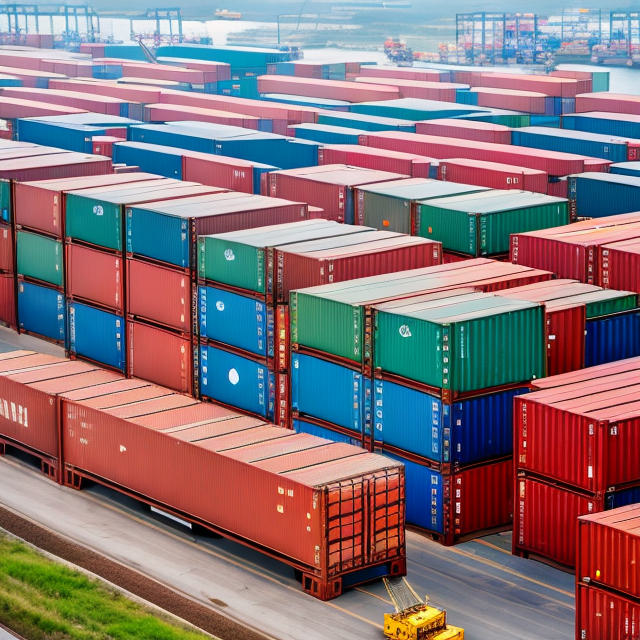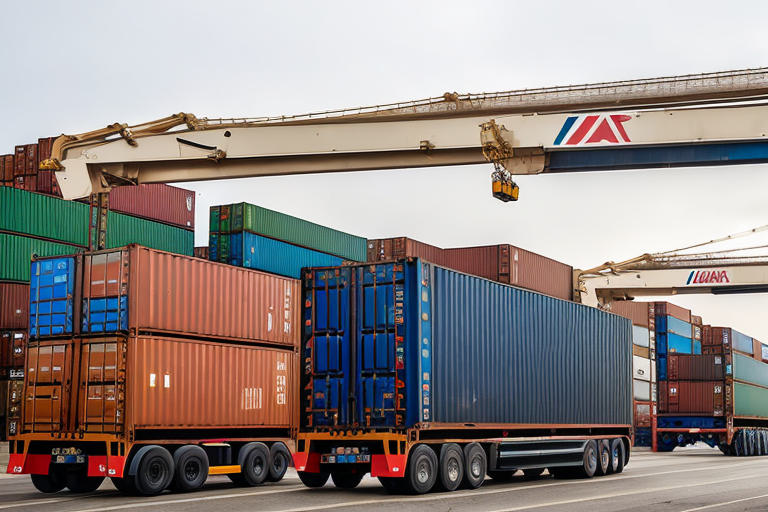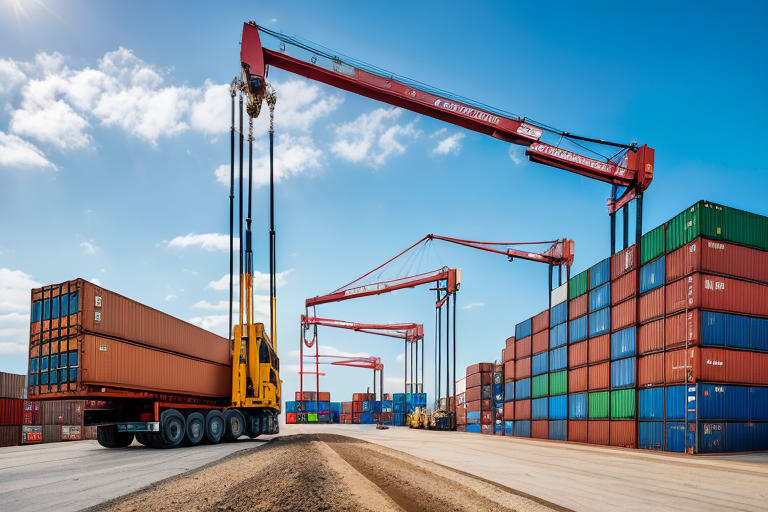Introduction
At Disk.com, we understand the importance of freight shipping for businesses. Freight shipping is a cost-effective and efficient way to transport goods, both domestically and internationally. In this guide, we will discuss the types of freight shipping providers, cost factors to consider, and best practices for successful freight shipping. We hope this guide will provide our clients with the necessary information to make informed decisions when it comes to their freight shipping needs.

Types of Freight Shipping Providers
Freight shipping providers are responsible for the transportation of goods from one location to another. There are many different types of providers available, each offering different services and advantages. It is important to understand the differences between them in order to make the best decision for your business.
Commonly Used Providers
The most commonly used freight shipping providers are truckload carriers, less-than-truckload carriers, railroads, air cargo carriers, and ocean shippers.
Truckload carriers transport large shipments in one truck from point A to point B. They typically provide door-to-door service and offer the most flexibility in terms of delivery times and routes.
Less-than-truckload (LTL) carriers transport smaller shipments that don’t fill an entire truck. These shipments are consolidated with other shipments and transported to their destination. LTL carriers typically offer more competitive rates than truckload carriers but have longer transit times.
Railroads are often used for long distance shipments or when time is not a factor. Rail transportation is usually cheaper than trucking but it can take several days to reach its destination.
Air cargo carriers specialize in transporting goods quickly over long distances. They offer the fastest transit times but also the highest costs.
Ocean shippers transport goods via container ships which can take weeks to reach their destination but offer some of the lowest rates available for international shipping.
Different Types of Carriers
In addition to the common providers mentioned above, there are also specialized freight shipping providers such as refrigerated carriers, flatbed carriers, and hazardous material carriers. Refrigerated carriers specialize in transporting temperature sensitive items such as food or medical supplies while flatbed carriers specialize in hauling large or oddly shaped items such as construction equipment or machinery. Hazardous material carriers are certified to transport dangerous goods that require special handling and documentation.
Pros and Cons of Different Providers
Each type of freight shipping provider has its own advantages and disadvantages depending on your needs. Truckload and LTL carriers offer door-to-door service which is convenient but can be more expensive than other options. Railroads offer competitive rates but may take longer to reach their destination. Air cargo is fast but expensive while ocean shippers provide the lowest rates but take much longer to deliver goods. Specialized providers such as refrigerated or hazardous material carriers may be necessary for certain shipments but come at a higher cost due to their specialized services.
It is important to consider all these factors when choosing a freight shipping provider in order to get the best value for your money while still meeting your needs.
Main Idea: Different types of freight shipping providers offer different services, advantages and disadvantages depending on needs. Interesting Key Findings: Truckload carriers provide door-to-door service, railroads offer competitive rates, air cargo is fast but expensive, ocean shippers provide lowest rates, specialized providers come at higher cost.
Cost Factors to Consider
When it comes to freight shipping, cost is often the deciding factor for shippers. To ensure you are making the best decisions for your business, it’s important to understand all the cost factors associated with freight shipping.
Pricing Models
The pricing models used by freight carriers vary and can be based on a variety of factors, such as the type of shipment, weight, volume, distance, and mode of transportation. Common pricing models include flat rate or fixed rate, per-mile rate, and dimensional weight pricing. Flat rate or fixed rate pricing charges a set fee based on the shipment’s destination zone. With per-mile rate pricing, carriers charge a certain amount per mile traveled. Dimensional weight pricing takes into account both the size and weight of a shipment when calculating costs.
Additional Costs
In addition to the base cost of shipping goods from one point to another, there are other costs that should be taken into consideration when budgeting for freight shipping. These additional costs include fuel surcharges, accessorial fees, port fees, customs and duties fees, taxes, and insurance costs. Fuel surcharges are applied when fuel prices increase due to market fluctuations and can add significantly to a shipment’s total cost. Accessorial fees are charged for services such as residential delivery or lift gate service. Port fees are charged for loading or unloading goods at ports or terminals and customs and duties fees are assessed when shipping internationally or between countries in North America. Taxes may also be applicable depending on the location of origin and destination of the shipment. Insurance is also an additional cost that should be considered when budgeting for freight shipping as it provides protection against lost or damaged shipments.
Fixed vs Variable Costs
Freight shipping costs can be divided into two categories: fixed costs and variable costs. Fixed costs refer to those costs that remain constant regardless of how much is shipped or how far it is shipped; these include labor costs and overhead expenses such as rent and utilities. Variable costs refer to those costs that fluctuate depending on how much is shipped or how far it is shipped; these include fuel surcharges, port fees, customs and duties fees, taxes, etc.
How to Lower Costs
There are several ways shippers can lower their freight shipping costs while still providing an excellent customer experience. One way is through consolidation – combining multiple small shipments into one larger shipment – which can reduce fuel surcharges as well as accessorial fees associated with multiple shipments being picked up from multiple locations. Another way is through optimization – using technology to analyze data points such as historical shipments data in order to identify opportunities for cost savings – which can help shippers reduce their overall freight spend by identifying more efficient routes or more cost-effective carriers. Additionally, shippers should consider working with third-party logistics (3PL) providers who specialize in managing freight shipments in order to take advantage of their knowledge of the industry and their ability to negotiate better rates with carriers on behalf of their clients.
| Pricing Models | Description |
| Flat Rate/Fixed Rate | Set fee based on destination zone. |
| Per-Mile Rate | Charge a certain amount per mile traveled. |
| Dimensional Weight Pricing | Takes into account size and weight of shipment when calculating costs. |
Best Practices for Freight Shipping
Freight shipping is an important part of the supply chain, and it’s important to have a solid understanding of best practices in order to ensure successful shipments. There are a number of steps that shippers should take to ensure that their freight is shipped safely and efficiently.

Preparing Shipments
Before shipping any freight, it’s important to ensure that all the necessary paperwork is completed correctly and that all of the items in the shipment are properly packaged and labeled. Shippers should also make sure to provide accurate information about the contents of the shipment, such as weight, size, and dimensions. This will help to avoid delays or problems with customs and regulations.
Packing and Labeling Shipments
Proper packaging and labeling of shipments is essential for ensuring that they arrive safely at their destination. It’s important to use materials that are strong enough to protect the items inside from damage during transit. Additionally, all packages should be clearly labeled with the shipper’s name, address, contact information, and a description of the contents.
Documentation Requirements
In order for freight shipments to cross borders or move through customs, certain documentation must be provided. This includes documents such as commercial invoices, packing lists, bills of lading, certificates of origin, and other country-specific documents. It’s important to make sure that all documentation is accurate and up-to-date in order to avoid delays or problems with customs authorities.
Tracking Shipments
Once a shipment has been sent out, it’s important to track its progress throughout its journey so that any potential issues can be identified quickly and addressed appropriately. Many carriers offer tracking systems that allow customers to monitor their shipments in real time and receive notifications when there are any changes in status or delays in transit.
Insurance and Liability Considerations
It’s important for shippers to understand their carrier’s insurance policies before sending out any shipments so they know what kind of protection they have in case something goes wrong during transit. Additionally, it’s important for shippers to understand their own liability in case of damage or loss during transit so they can take appropriate measures to protect themselves financially.
Working with Customs & Regulations
When shipping across borders or through customs, there are a number of rules and regulations that must be followed in order for shipments to pass through successfully. It’s important for shippers to understand these rules so they can ensure that their shipments comply with all applicable laws and regulations.
Quality Control Procedures
In order to ensure that shipments arrive at their destination without any damage or defects, it’s important for shippers to establish quality control procedures prior to sending out any freight shipments. These procedures should include regular inspections before shipment as well as proper packaging and labeling techniques in order to reduce the risk of damage during transit.
Choosing the Right Provider
When selecting a freight provider, it’s important for shippers to consider factors such as price, reliability, service quality, delivery timescales, insurance coverage, customer service levels, and more in order to find the best fit for their needs. It’s also helpful to read reviews from other customers who have used the provider before making a decision so you can get an idea of what kind of experience you can expect from them.
| Best Practices | Description |
| Preparing Shipments | Ensure all paperwork is completed and items are properly packaged and labeled. |
| Packing and Labeling Shipments | Use strong materials to protect items during transit, label packages with shipper’s info. |
| Documentation Requirements | Provide necessary documents such as commercial invoices, packing lists, etc. |
| Tracking Shipments | Monitor progress of shipments in real-time to identify potential issues. |
| Insurance & Liability Considerations | Understand carrier’s insurance policies and shipper’s liability for damage or loss. |
| Working with Customs & Regulations | Understand rules and regulations for crossing borders or moving through customs. |
| Quality Control Procedures | Establish procedures for inspections before shipment, proper packaging and labeling. |
| Choosing the Right Provider | Consider factors such as price, reliability, service quality, delivery timescales, etc. |
Conclusion
Freight shipping is an essential part of the global supply chain, allowing businesses to ship goods across the country or around the world with ease. While there are many factors to consider when selecting a provider and managing your shipments, understanding the different types of providers, cost structures, and best practices can help you make informed decisions and ensure successful deliveries. At Disk.com, we are dedicated to providing our clients with comprehensive printing, manufacturing and fulfillment solutions that meet their unique needs. With our concierge service and custom tailored fulfillment plans, we strive to deliver high quality products at budget-friendly prices and provide complete shipping, tracking and customer service so our clients can focus on running their businesses.


